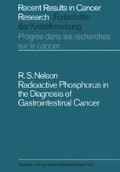Abstract
Clinical use of the radioactive phosphorus (P32) test naturally expanded first in the more accessible regions of the body. Areas such as the eye, skin and breast could be carefully evaluated for relatively long periods and, if necessary, repeatedly with little discomfort to the patient. The difficulty of instrumentation in the gastrointestinal tract presented a natural barrier to clinical evaluation. During the period of early delay, a basic study (Schulman et al., 1949) on phosphorus turnover in human gastric carcinoma, shed some light on the possible usefulness of the test in the stomach. Following subtotal gastrectomy in three patients with nonmalignant disease and six with various gross types of cancer, who had been given 1 µc. of P32 per pound of body weight 36 hours prior to surgery, mucosa was stripped from the stomach wall in all cases, and samples taken of tumor mass. Analysis showed that the phosphorus content of mucosa from stomach with either benign or malignant disease, was essentially the same. The phosphorus content of gastric mucosa, whether associated with benign or malignant disease, and cancerous tissue, was also the same, but the rate of phosphorus turnover was 47 per cent higher in gastric carcinoma than in other gastric tissue. There was a 124 per cent increase in the turnover of protein phosphorus and a 45 per cent increase in the turnover of lipid phosphorus, but the acid-soluble phosphorus turnover remained unchanged. The increased activity of tumor phosphorus in the stomach demonstrated the possible usefulness of the P82 test in differential diagnosis of gastric lesions.
Access this chapter
Tax calculation will be finalised at checkout
Purchases are for personal use only
Preview
Unable to display preview. Download preview PDF.
References
Ackerman, N. B., D. B. Shahon, A. S. McFee, and O. H. Wangensteen: Recognition of gastric cancer by in vivo radioautography. Ann. Surg. 152, 602 (1960).
Ackerman, A. S. McFee, and O. H. Wangensteen: Refinements in technique of in vivo radioautography of the stomach. Surgery 51, 295 (1962).
Ackerman, J. A. Blum, E. L. Makowski, and O. H. Wangensteen: Multiple-organ cancer screening with diagnostic radioautographic procedures. J. Amer. med. Ass. 183, 36 (1963).
Nakayama, K.: Diagnostic significance of radioactive isotopes in early cancer of alimentary tract, especially esophagus and cardia. Surgery 39, 736 (1956).
Nelson, R. S., W. C. Dewey, and R. G. Rose: The use of radioactive phosphorus (P32) and a miniature Geiger tube to detect malignant neoplasia of the gastrointestinal tract. Gastroenterology 46, 8 (1964).
Otto, D. L., N. H. Horwitz, R. S. Kurtzman, and J. E. Lofstrom: Radioactive I131 and P32 as aids in the diagnosis of lesions of the stomach. Amer. J. Roentgen. 91, 66 (1964).
Schulman, J., jr., M. Falkenheim, and S. J. Gray: Phosphorus turnover of carcinoma of human stomach as measured with radioactive phosphorus. J. clin. Invest. 28, 66 (1949).
Stein, G. N., V. O. Tachdjian, N. Magid, and F. Vilardell: Evaluation of balloon radio-autography in the differentiation of benign and malignant gastric lesions. Arch. int. Med. 115, 326 (1965).
Voznyuk, E. I.: The use of radiophosphorus P32 in diagnosing stomach cancer. Un. int. Cancr. 19, 1184 (1963).
Author information
Authors and Affiliations
Rights and permissions
Copyright information
© 1967 Springer-Verlag Berlin · Heidelberg
About this chapter
Cite this chapter
Nelson, R.S. (1967). Radioactive Phosphorus (P32) in the Diagnosis of Gastrointestinal Cancer. In: Radioactive Phosphorus in the Diagnosis of Gastrointestinal Cancer. Recent Results in Cancer Research / Fortschritte der Krebsforschung / Progrès dans les recherches sur le cancer, vol 10. Springer, Berlin, Heidelberg. https://doi.org/10.1007/978-3-642-99926-0_2
Download citation
DOI: https://doi.org/10.1007/978-3-642-99926-0_2
Publisher Name: Springer, Berlin, Heidelberg
Print ISBN: 978-3-642-99928-4
Online ISBN: 978-3-642-99926-0
eBook Packages: Springer Book Archive

